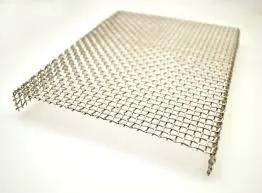-
+86 15030157877
-
sales@galvanizedmetalmesh.com
Lis . 27, 2024 14:04 Back to list
Durable Stainless Steel Grating Solutions for Industrial and Commercial Applications
The Versatility and Applications of Stainless Steel Grating
Stainless steel grating has emerged as an essential architectural element in various industries, thanks to its unique combination of durability, strength, and aesthetic appeal. Made from alloys resistant to corrosion and staining, stainless steel grating offers a high level of performance even in demanding environments, making it ideal for a wide range of applications.
Characteristics of Stainless Steel Grating
One of the most significant advantages of stainless steel grating is its corrosion resistance. Unlike traditional materials, such as carbon steel, stainless steel maintains its integrity when exposed to moisture, chemicals, and extreme temperatures. This property is particularly important in environments like food processing plants, wastewater treatment facilities, and chemical manufacturing plants, where exposure to harsh substances is common.
Additionally, stainless steel grating is designed with load-bearing capabilities that are highly effective for supporting heavy machinery and foot traffic. The open design of grates allows for excellent drainage and airflow, which reduces the risk of hazards such as slipping or flooding. The strength-to-weight ratio of stainless steel makes it a practical choice for sectors needing robust flooring solutions without excessive bulk.
Types of Stainless Steel Grating
There are several types of stainless steel grating available in the market, tailored to meet different needs. The most common forms include
1. Bar Grating This type consists of parallel bars spaced apart to create a grid-like structure. It is ideal for walkways, platforms, and industrial areas due to its high strength and durability.
2. Safety Grating Designed with serrated surfaces, safety grating provides enhanced slip resistance, making it suitable for wet or oily environments. It is often used in factories, kitchens, and outdoor areas prone to moisture.
3. Hybrid Grating Combining different materials or designs, hybrid grating can offer unique characteristics tailored to specific applications. These might include variations in load capacity or surface treatments for added protection.
4. Architectural Grating While still functional, architectural grating is designed with aesthetics in mind. It is commonly used in public spaces, parks, and high-end commercial properties, contributing to both safety and visual appeal.
stainless steel grating

Applications of Stainless Steel Grating
The versatility of stainless steel grating means it can be found in a myriad of applications, which include
- Industrial Facilities Used for flooring, walkways, and platforms, stainless steel grating supports equipment and personnel while allowing for drainage and ventilation.
- Marine Environments Its resistance to saltwater corrosion makes stainless steel grating a preferred choice for piers, docks, and other marine structures.
- Food and Beverage Industries Since stainless steel is easily sanitized, it is widely used in food processing plants and commercial kitchens to prevent contamination while complying with health regulations.
- Wastewater Treatment Stainless steel’s durability and resistance to chemicals make it suitable for use in facilities that process sewage and other waste materials.
- Architectural Applications Stainless steel grating is also employed in rooftop gardens, decorative facades, and urban landscapes, where it combines function with aesthetic design.
Conclusion
Stainless steel grating captures a unique intersection of functionality, aesthetics, and longevity, making it an incredibly valuable material in various sectors. Its corrosion-resistant properties ensure that it can withstand a wide range of environmental conditions, while the myriad types available cater to specific requirements across industries.
As industries continue to evolve and emphasize both performance and safety, the demand for stainless steel grating is likely to rise. Its applications will expand further, positioning it as a staple in modern construction and industrial design. Whether it's ensuring safety in a manufacturing facility or enhancing the beauty of a public space, stainless steel grating stands out as a versatile and essential component in our built environment.
-
Premium Rib Lath for Durable Stucco & Plaster Systems
NewsAug.13,2025
-
3D Curved Welded Mesh Fence: Enhanced Security & Durability
NewsAug.12,2025
-
Custom Crimped Wire Mesh | High Quality & Wholesale Supply
NewsAug.11,2025
-
Heavy-Duty Stackable Storage Cages – Secure & Space-Saving
NewsAug.10,2025
-
Stainless Steel Angle Factories | Top Suppliers & Manufacturers
NewsAug.09,2025
-
Artificial Grass Fence: Privacy, Beauty & Low Maintenance
NewsAug.08,2025



